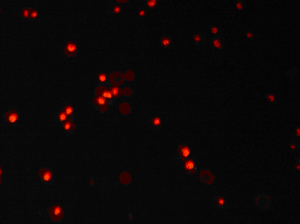|
|
| |
|
Malaria
Malaria is one of the ‘big three´ infectious diseases (malaria, HIV/AIDs and tuberculosis) that between them are responjsible for most deaths around the world.
It is caused by one of four closely related Plasmodium parasites:- falciparum, vivax malariae and ovale. Carried by mosquitos they first enter the liver before infecting the red blood cells. They all hide from the immune system in the red blood cell where they grow and reproduce.
Malaria is continuing to be a threat due to the emergence of resistant strains.

For further information there are many excellent sites such as www.malaria.org and you can find more under the links on this site. The classic diagnostic test is to use a a light microscope equipped with a x100 oil immersion lens for inspection of a Giemsa stained slide smeared with blood of the patient. At low levels of parisitemia even experts might fail to detect the parasite. A further simple and perhaps more effective test is to stain the nucleic acid of the parasite inside the red blood cell (which has no nucleus) with acridine orange.
Uisng a x40 objective the slide can be scanned more quickly and due to the high contrast is more sensitive.
Here we show erythrocytes infected with Plasmodium falciparum (courtesy of Prof. Lingelbach and Dr. Nyalwidhe Marburg)
However using computer image graphics we can also combine the transmission image with the fluorescence image which shows clearly that the parasites are within the red blood cells.

|
|
|